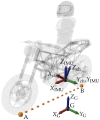Roll Angle Estimation of a Motorcycle through Inertial Measurements
- PMID: 34640946
- PMCID: PMC8512544
- DOI: 10.3390/s21196626
Roll Angle Estimation of a Motorcycle through Inertial Measurements
Abstract
Currently, the interest in creating autonomous driving vehicles and progressively more sophisticated active safety systems is growing enormously, being a prevailing importance factor for the end user when choosing between either one or another commercial vehicle model. While four-wheelers are ahead in the adoption of these systems, the development for two-wheelers is beginning to gain importance within the sector. This makes sense, since the vulnerability for the driver is much higher in these vehicles compared to traditional four-wheelers. The particular dynamics and stability that govern the behavior of single-track vehicles (STVs) make the task of designing active control systems, such as Anti-lock Braking System (ABS) systems or active or semi-active suspension systems, particularly challenging. The roll angle can achieve high values, which greatly affects the general behavior of the vehicle. Therefore, it is a magnitude of the utmost importance; however, its accurate measurement or estimation is far from trivial. This work is based on a previous paper, in which a roll angle estimator based on the Kalman filter was presented and tested on an instrumented bicycle. In this work, a further refinement of the method is proposed, and it is tested in more challenging situations using the multibody model of a motorcycle. Moreover, an extension of the method is also presented to improve the way noise is modeled within this Kalman filter.
Keywords: Kalman filter; LQR controller; inertial sensors; motorcycle lean angle; roll angle estimator.
Conflict of interest statement
The authors declare no conflict of interest.
Figures









References
-
- Schwab A.L., De Lange P.D., Happee R., Moore J.K. Rider control identification in bicycling using lateral force perturbation tests. Proc. Inst. Mech. Eng. Part K J. Multi-Body Dyn. 2013;227:390–406. doi: 10.1177/1464419313492317. - DOI
-
- Cossalter V., Sadauckas J. Elaboration and quantitative assessment of manoeuvrability for motorcycle lane change. Veh. Syst. Dyn. 2006;44:903–920. doi: 10.1080/00423110600742072. - DOI
-
- Schlipsing M., Schepankek J., Salmen J. Video-Based Roll Angle Estimation for Two-Wheeled Vehicles; Proceedings of the 2011 IEEE Intelligent Vehicles Symposium (IV); Baden-Baden, Germany. 5–9 June 2011; - DOI
-
- Teerhuis a.P., Jansen S.T. Motorcycle state estimation for lateral dynamics. Veh. Syst. Dyn. 2012;50:1261–1276. doi: 10.1080/00423114.2012.656655. - DOI
-
- Nehaoua L., Ichalal D., Arioui H., Davila J., Mammar S., Fridman L.M. An Unknown-Input HOSM Approach to Estimate Lean and Steering Motorcycle Dynamics. IEEE Trans. Veh. Technol. 2014;63:3116–3127. doi: 10.1109/TVT.2014.2300633. - DOI
MeSH terms
Grants and funding
LinkOut - more resources
Full Text Sources

